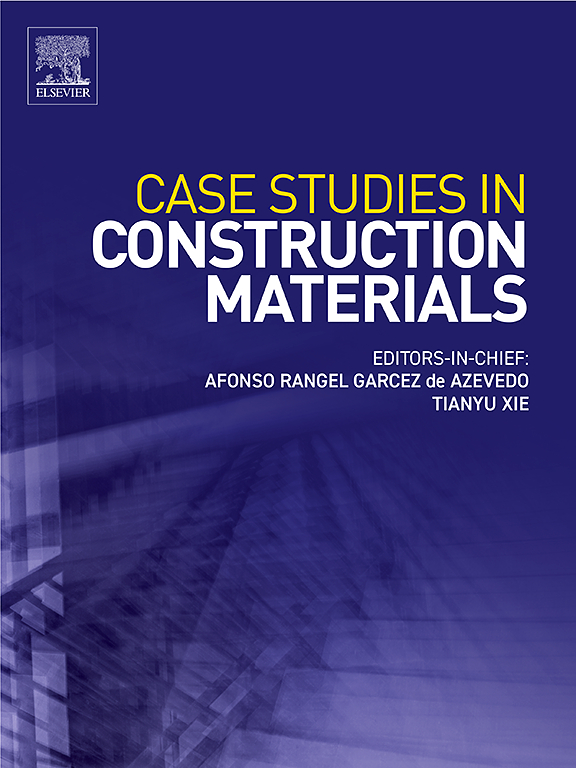Prediction of compressive strength and characteristics analysis of semi-flexible pavement desert sand grouting material based upon hybrid-BP neural network
IF 6.5
2区 工程技术
Q1 CONSTRUCTION & BUILDING TECHNOLOGY
引用次数: 0
Abstract
Evaluating the mechanical properties of desert sand grouting Material (DSGM) utilized in semi-flexible pavement within practical engineering applications is crucial for ensuring its safe utilization. To precisely obtain DSGM exhibiting exceptional mechanical properties, the Backpropagation Neural Network (BPNN) model was optimized through the utilization of Particle Swarm Optimization (PSO), Sparrow Search Algorithm (SSA), and Genetic Algorithm (GA). Relationships between water-cement (w/c) ratio, desert sand (DS) content, fly ash (FA) content, bentonite (BT) content, and superplasticizer (SP) dosage were established in relation to compressive strength. Experimental flexural and compressive strengths served as evaluative indices for the mechanical properties of DSGM. Correlation matrix analysis and Principal Component Analysis (PCA) were conducted to ascertain the relationships between various raw materials and the mechanical properties of DSGM, while comparative analyses were also performed on these mechanical property evaluative indices.The results indicated a positive correlation between DS content and SP dosage with compressive strength, whereas a negative correlation was observed between w/c ratio, FA content, and BT content with compressive strength. DS effectively dispersed the DSGM cementitious material slurry, leading to a more uniform distribution of hydration products and a stronger bond in the transition zone of the aggregate interface. Consequently, the DSGM matrix structure became more dense, resulting in higher compressive strength. Through PCA, the importance of different variables and their overall scores were analyzed, revealing Group NO12 as the optimal mix ratio. The GA algorithm significantly enhanced the predictive accuracy of the BPNN model. The predictive performance evaluative indices for compressive strength using GA - BPNN were R² = 0.93, MAE = 2.39, MAPE = 0.06, and RMSE = 3.18. Therefore, GA - BPNN demonstrated the highest predictive accuracy for the compressive strength of DSGM, providing novel insights for the mix design of DSGM.
基于混合bp神经网络的半柔性路面沙漠砂灌浆材料抗压强度预测及特性分析
在实际工程应用中,评价沙漠砂灌浆材料在半柔性路面中的力学性能是保证其安全使用的关键。为了精确获得具有优异力学性能的DSGM,利用粒子群算法(PSO)、麻雀搜索算法(SSA)和遗传算法(GA)对反向传播神经网络(BPNN)模型进行了优化。建立了水灰比(w/c)、荒漠砂(DS)含量、粉煤灰(FA)含量、膨润土(BT)含量、高效减水剂(SP)用量与抗压强度的关系。试验抗折强度和抗压强度作为DSGM力学性能的评价指标。通过相关矩阵分析和主成分分析(PCA)确定了各种原料与DSGM力学性能之间的关系,并对这些力学性能评价指标进行了对比分析。结果表明,DS含量、SP用量与抗压强度呈显著正相关,w/c比、FA含量、BT含量与抗压强度呈显著负相关。DS有效分散了DSGM胶凝材料浆体,使水化产物分布更均匀,骨料界面过渡区粘结更强。因此,DSGM基体结构变得更加致密,抗压强度更高。通过主成分分析法,分析各变量的重要性及其综合得分,得出NO12组为最优混合比例。遗传算法显著提高了bp神经网络模型的预测精度。GA - BPNN抗压强度预测性能评价指标为R²= 0.93,MAE = 2.39,MAPE = 0.06,RMSE = 3.18。因此,GA - BPNN对DSGM抗压强度的预测精度最高,为DSGM的混合设计提供了新的见解。
本文章由计算机程序翻译,如有差异,请以英文原文为准。
求助全文
约1分钟内获得全文
求助全文
来源期刊

Case Studies in Construction Materials
Multiple-
CiteScore
7.60
自引率
19.40%
发文量
842
审稿时长
63 days
期刊介绍:
Case Studies in Construction Materials provides a forum for the rapid publication of short, structured Case Studies on construction materials. In addition, the journal also publishes related Short Communications, Full length research article and Comprehensive review papers (by invitation).
The journal will provide an essential compendium of case studies for practicing engineers, designers, researchers and other practitioners who are interested in all aspects construction materials. The journal will publish new and novel case studies, but will also provide a forum for the publication of high quality descriptions of classic construction material problems and solutions.
 求助内容:
求助内容: 应助结果提醒方式:
应助结果提醒方式:


